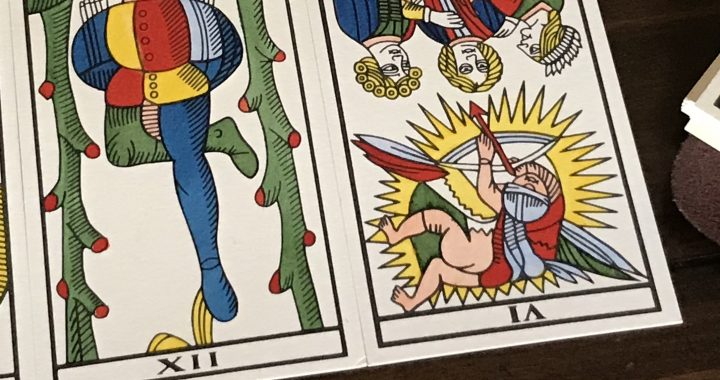For as long as I have been reading Tarot, I always had a preference for historical decks, I am especially fond of the Marseille style. These days, I mostly use the Jean Noblet and Jean Dodal, dating respectively from 1650 and 1701.
I like their iconicity, the way these simple images can most directly relate to the story we must tell the querent. In contrast to many more modern decks, it is that simplicity that allows our imagination to roam over these simple images and trigger the interpretations we give them and the story they convey. Directly, without having the ned to memorize lists of keywords or additional systems.
If we look back at the period when these early Italian and Marseille tarots were created, the 15th to the 18th century, reading and writing was reserved to the clergy and a few privileged people of the upper class. I would be really surprised if the ancestors of our grandmothers, … would have had the skills to read a book. So, the only way left to interpret these cards, supposing they were already used for divination, would be by decoding the images, what is commonly called the language of the birds. The way it works would be looking at people’s postures, where they are looking, what they are doing…
The 3 cards reading is certainly one of the best tools we can have in our arsenal. Not only are 3 cards enough to give an basic interpretation to any question asked, but they are also the building blocks to many more complex spreads, such as the square of 9, Etteilla’s great star of 13 cards, or even Etteilla’s 3 steps, a complex spread using 23 cards. In all these, and many others, even if they are composed of many cards, they are read in triplets, with exactly the same techniques a 3 cards reading is done.
When reading a 3 cards spread, we read a story of 3 cards, not 3 cards separated from each other. We look for the big picture first, the whole of the spread instead of details. We don’t look for pre learned meanings, we look how each element fits visually in the story. Reading card per card and using preconceived meanings would be the equivalent of interrupting the lecture of a sentence at every word, and looking for its definitions, and trying to make sense of each word by itself. Not much sense doing that, in why opinion, with these historical decks.
As an example is often better that a long explanation, let’s take 3 cards and I’ll show how reading them could be practiced.

Here we have LAMOUREU, LE PANDU, and JUSTICE, or the Lovers, the Hanged Man, and Justice.
What is happening here? In the lovers, a man is caught in between two women. Each one seems to pull him in their direction. On top of them, we find an angel, a cupid, blindfolded, who seems ready to throw an arrow. Next is the hanged man, where we see a man hanged by a foot, in between two poles. And finally Justice, where the figure is seated, weighting with a balance and holding a sword vertically in the other hand.
How do we feel seeing this story? The man in the hanged man does not seem to have any power over what is happening. He is just hanging, head low to the ground. But how did this happen? Looking at the lovers, we see that man hesitating between these two women, being pulled left and right. There is no sense of power here either. At the limit, if there was power somewhere, it would be that cupid finally delivering that arrow, but he is blindfolded, where he would throw would be dictated by chance.
So, how do we feel at this point in the story? The man has been hanged, is powerless because there is no sense that a decision was made in the lovers. Hesitating renders him immobile, impotent to move forward.
Hopefully, we have justice last. She is weighting the platters on the balance and her sword is raised. As if she would be ready to cut the cord of the hanged man when she has finished weighting the platters, and finally liberate him. Justice is the only place where we see someone having power in this story.
The idea is simple in this example, the concept is that hesitations and lack of decision will let you hanged, incapable of moving, until a decision is finally made. Pick something or be damned.
As an interesting point, is that we reconstructed the full reading without even asking a question, using mostly descriptions that lead us to some meaning. We can leave it that way, the querent will certainly make a link between a choice to be made and his/her own life. They usually know what their problems are, where a choice in their life is paralyzing them. This spread appears simple, but is certainly a conversation opening to dig deeper into the querent’s problems.
Deck: Jean Dodal, hand stenciled edition, by JC Flornoy.
